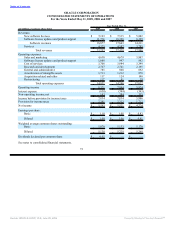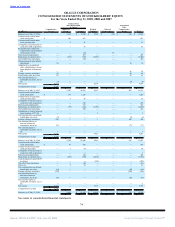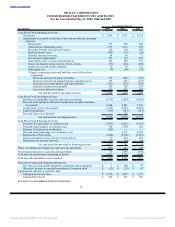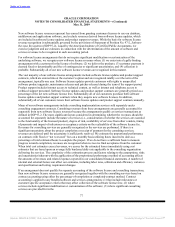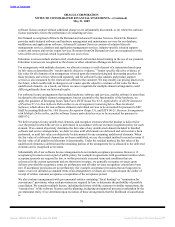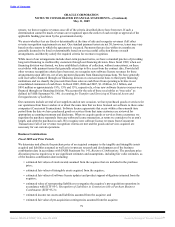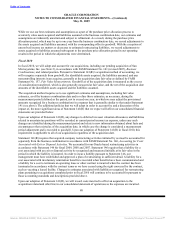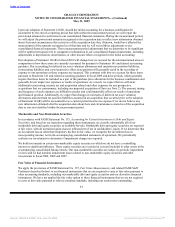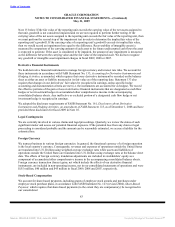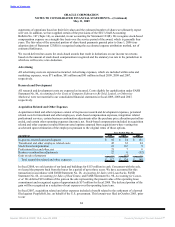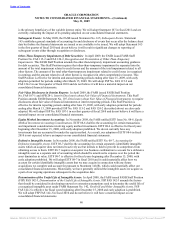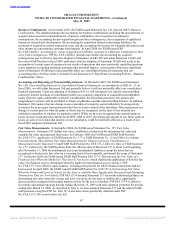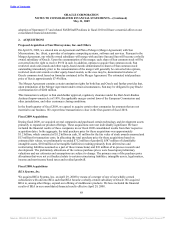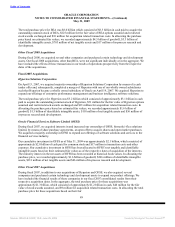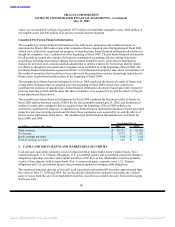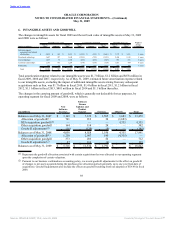Oracle 2008 Annual Report Download - page 91
Download and view the complete annual report
Please find page 91 of the 2008 Oracle annual report below. You can navigate through the pages in the report by either clicking on the pages listed below, or by using the keyword search tool below to find specific information within the annual report.
Table of Contents
ORACLE CORPORATION
NOTES TO CONSOLIDATED FINANCIAL STATEMENTS—(Continued)
May 31, 2009
Note 15 below. If the fair value of the reporting unit exceeds the carrying value of the net assets assigned to
that unit, goodwill is not considered impaired and we are not required to perform further testing. If the
carrying value of the net assets assigned to the reporting unit exceeds the fair value of the reporting unit, then
we must perform the second step of the impairment test in order to determine the implied fair value of the
reporting unit’s goodwill. If the carrying value of a reporting unit’s goodwill exceeds its implied fair value,
then we would record an impairment loss equal to the difference. Recoverability of intangible assets is
measured by comparison of the carrying amount of each asset to the future undiscounted cash flows the asset
is expected to generate. If the asset is considered to be impaired, the amount of any impairment is measured
as the difference between the carrying value and the fair value of the impaired asset. We did not recognize
any goodwill or intangible asset impairment charges in fiscal 2009, 2008 or 2007.
Derivative Financial Instruments
We hold derivative financial instruments to manage foreign currency and interest rate risks. We account for
these instruments in accordance with FASB Statement No. 133, Accounting for Derivative Instruments and
Hedging Activities, as amended, which requires that every derivative instrument be recorded on the balance
sheet as either an asset or liability measured at its fair value as of the reporting date. Statement 133 also
requires that changes in our derivatives’ fair values be recognized in earnings, unless specific hedge
accounting and documentation criteria are met (i.e. the instruments are accounted for as hedges). We record
the effective portions of the gain or loss on derivative financial instruments that are designated as cash flow
hedges or net investment hedges in accumulated other comprehensive income in the accompanying
consolidated balance sheets. Any ineffective or excluded portion of a designated cash flow hedge or net
investment hedge is recognized in earnings.
We adopted the disclosure requirements of FASB Statement No. 161, Disclosures about Derivative
Instruments and Hedging Activities, an amendment of FASB Statement 133, as of December 1, 2008 and have
provided these disclosures for fiscal 2009 in Note 10.
Legal Contingencies
We are currently involved in various claims and legal proceedings. Quarterly, we review the status of each
significant matter and assess our potential financial exposure. If the potential loss from any claim or legal
proceeding is considered probable and the amount can be reasonably estimated, we accrue a liability for the
estimated loss.
Foreign Currency
We transact business in various foreign currencies. In general, the functional currency of a foreign operation
is the local country’s currency. Consequently, revenues and expenses of operations outside the United States
are translated into U.S. Dollars using weighted average exchange rates while assets and liabilities of
operations outside the United States are translated into U.S. Dollars using exchange rates at the balance sheet
date. The effects of foreign currency translation adjustments are included in stockholders’ equity as a
component of accumulated other comprehensive income in the accompanying consolidated balance sheets.
Foreign currency transaction (losses) gains, net which include the effects of our derivative financial
instruments, are included in non-operating income, net in our consolidated statements of operations and were
$(55) million, $40 million and $45 million in fiscal 2009, 2008 and 2007, respectively.
Stock-Based Compensation
We account for share-based payments, including grants of employee stock awards and purchases under
employee stock purchase plans, in accordance with FASB Statement No. 123 (revised 2004), Share-Based
Payment, which requires that share-based payments (to the extent they are compensatory) be recognized in
our consolidated
83
Source: ORACLE CORP, 10-K, June 29, 2009 Powered by Morningstar® Document Research℠


